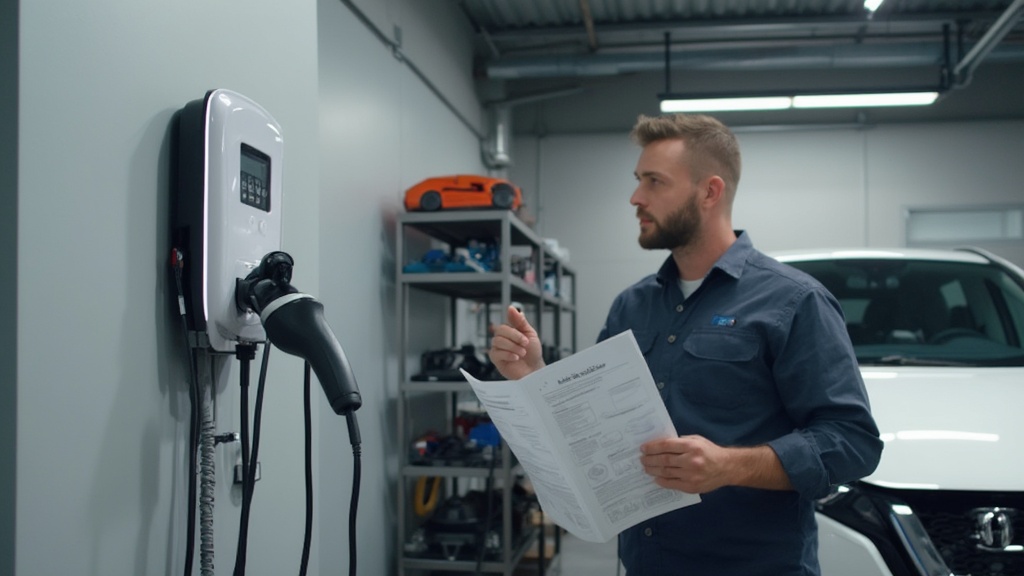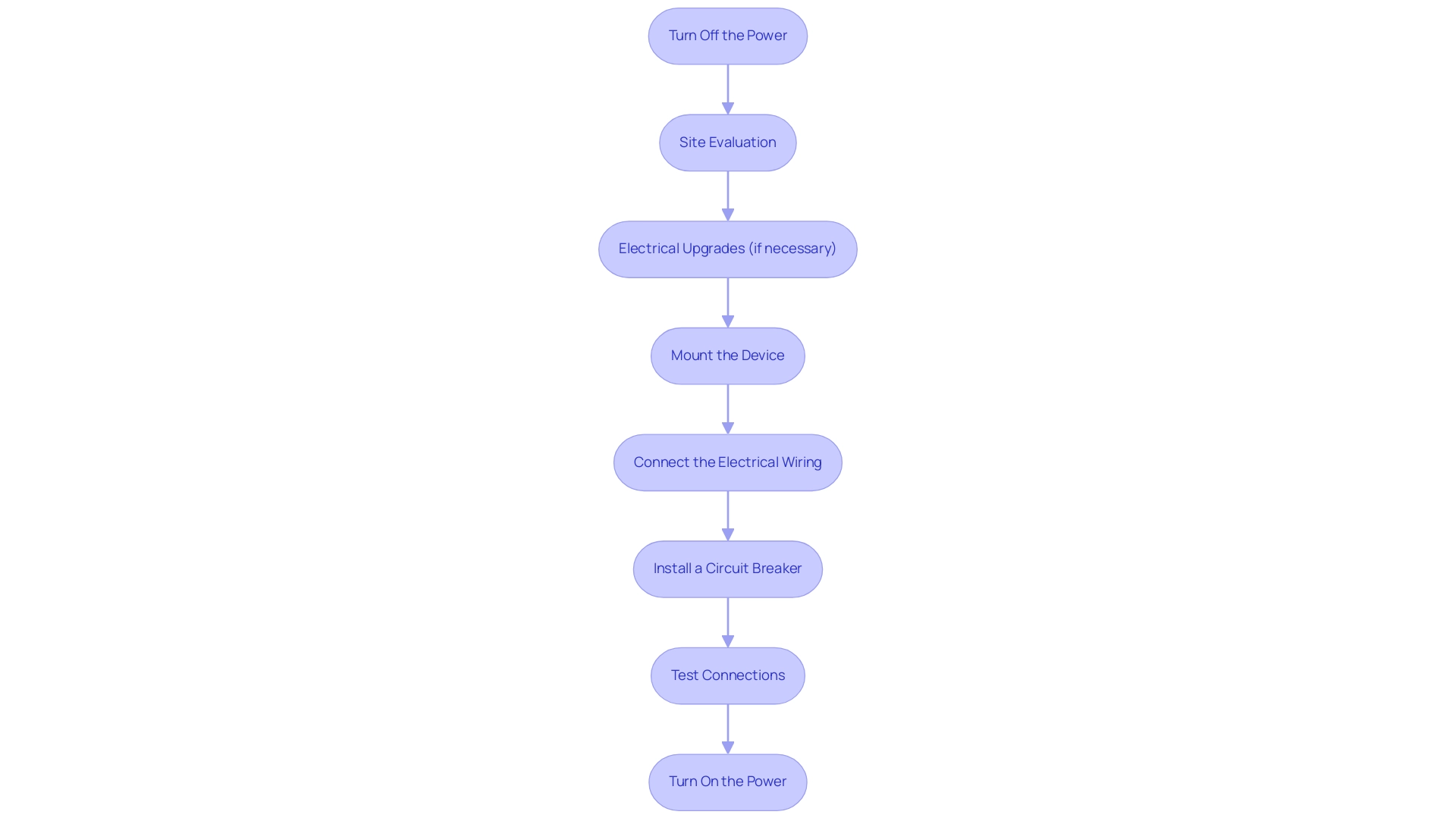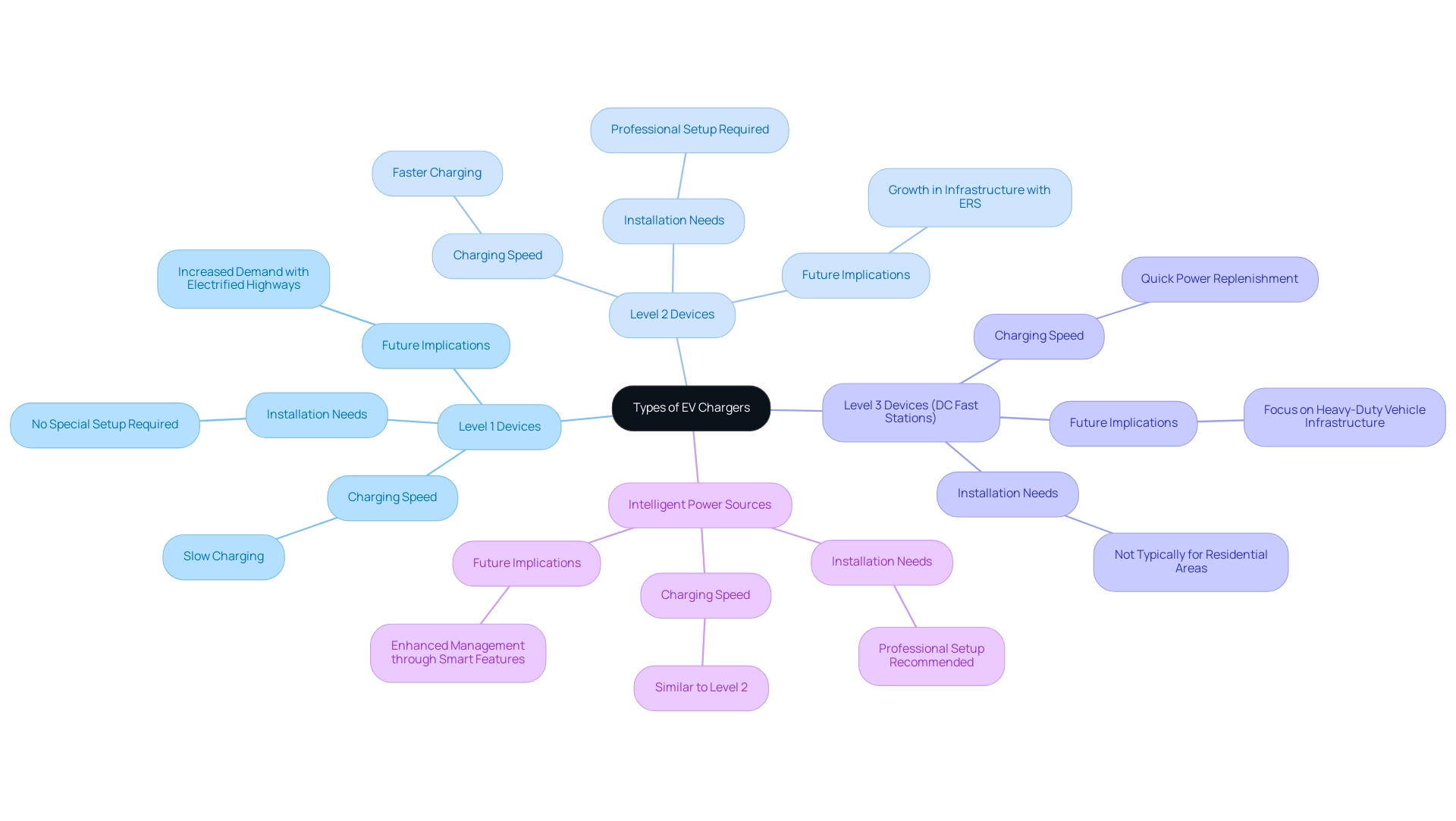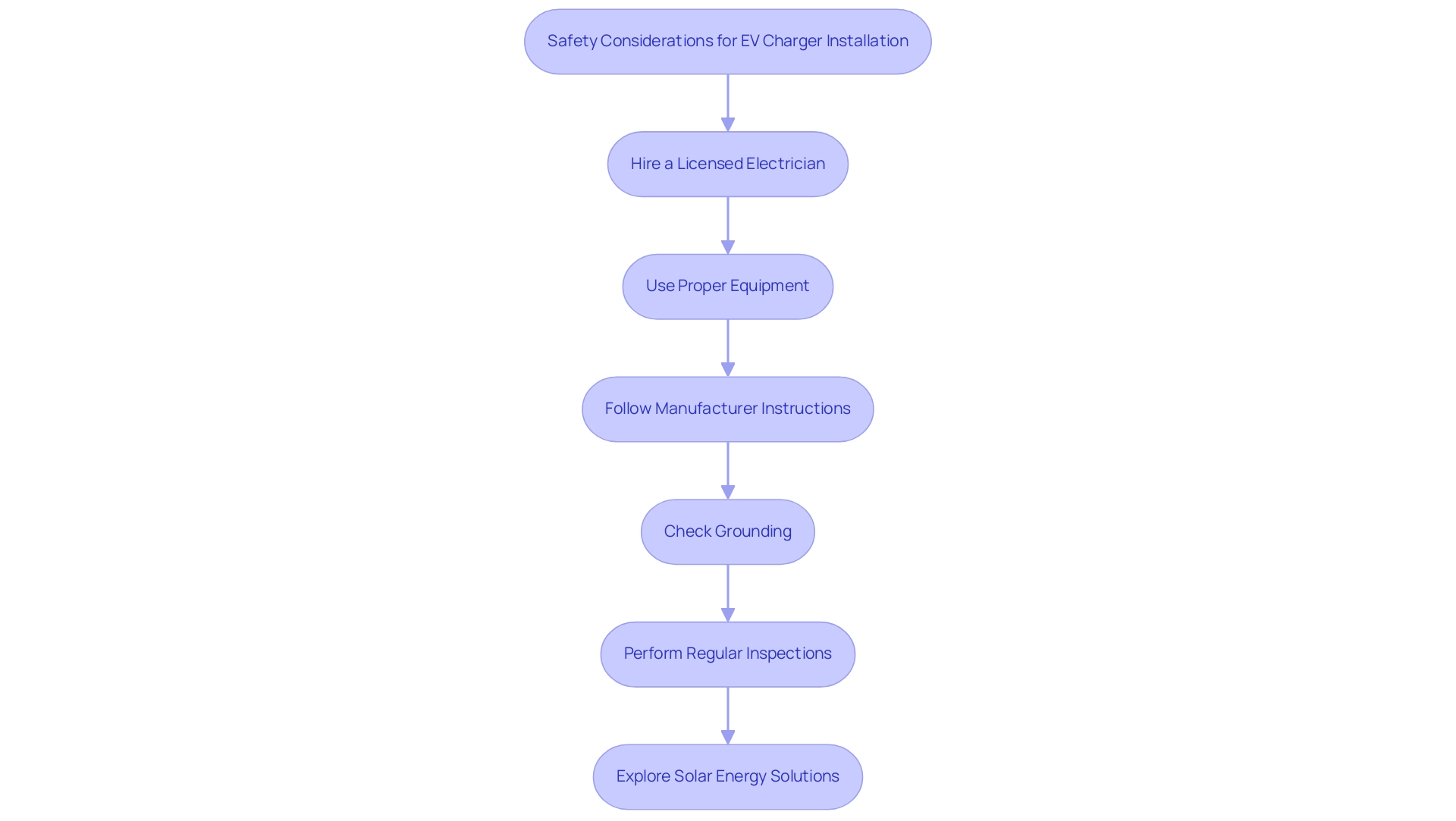Overview
To install an EV charger in your garage, one must assess the garage space, check power capacity, and follow safety regulations while preparing for the installation process. The article outlines essential steps including site evaluation, electrical upgrades if necessary, and the importance of professional assistance to ensure safety and compliance, thereby facilitating a successful and efficient installation.
Introduction
As electric vehicles (EVs) continue to gain popularity, the importance of having a reliable home charging solution is becoming increasingly apparent. Homeowners are now faced with the exciting yet daunting task of preparing their garages for EV charger installations.
From assessing available space and checking electrical capacity to understanding the various types of chargers, each step plays a crucial role in ensuring a smooth and efficient installation process. This guide provides a comprehensive overview of what to consider before diving into the installation, helping homeowners navigate the transition to electric driving while enhancing their home’s functionality and sustainability.
With the right preparation and knowledge, embracing this eco-friendly lifestyle becomes not just feasible, but also rewarding.
Preparing Your Garage for EV Charger Installation
-
Assess Your Garage Space: Begin by taking a good look at your garage. You want to ensure there’s ample space not just for the device, but also for your vehicle to move around comfortably. Consider how you park and maneuver your area to prevent any future irritations—after all, you don’t want to collide with objects while you’re powering up! With Korea having installed over 200,000 public chargers to date, it’s clear that the demand for EV infrastructure is on the rise, which emphasizes the importance of knowing how to install ev charger in garage. Plus, integrating solar panels into your home can enhance your energy efficiency while charging your EV. Consider also the best solar battery choices for efficient energy storage, as this can further optimize your energy use and reduce costs.
-
Check Power Capacity: It’s a smart move to bring in a licensed electrician to assess your garage’s power system. They can help you figure out how to install an EV charger in your garage if your setup can handle it. Sometimes, you might need to upgrade your electrical panel to accommodate the new power needs, so it’s best to tackle this early on. Asensio notes, “People are getting frustrated because they don’t feel like they’re getting their money’s worth,” highlighting how proper installation can alleviate concerns and ensure value. Powercore Electric is here to assist with these necessary upgrades, ensuring your home is ready for the future.
-
Identify the Best Location: Pick a spot for your device that’s easily accessible. Ideally, you’ll want it near an outlet or a place where the electrical wiring can be connected without a hassle. Consider how you’ll park—having the charger close to where you park can save time and effort.
-
Clear the Area: Take a moment to declutter your setup area. Remove any obstacles or unnecessary items to create a safe and tidy workspace. A tidy space not only simplifies the setup but also guarantees safety throughout the process.
-
Gather Necessary Tools and Materials: Before starting the setup, collect all the tools you’ll need—think drills, screwdrivers, and any materials like mounting brackets and electrical wiring. Having everything ready on hand can make the process smoother and more efficient.
-
Review Local Codes and Permits: Don’t forget to touch base with your local building authority! It is crucial to understand how to install ev charger in garage, along with the regulations and permits required for EV charging installation in your area. This step not only ensures compliance but can also save you from potential headaches down the road. The expanding infrastructure for EV stations, as demonstrated in the European EV Charging Market Growth case study where the number of publicly accessible units in Europe rose by 30% in 2021, reflects a strong commitment to supporting electric vehicle adoption, which aligns with the shift towards renewable energy sources like solar.
-
Installation Process: Once you have everything prepared, follow the manufacturer’s instructions on how to install ev charger in garage. Typically, this includes securing the device to the wall or mounting bracket, connecting the electrical wiring, and ensuring all connections are properly insulated. It’s advisable to have a professional oversee or assist with this part to ensure safety and compliance with local codes.
Armed with these steps, you’ll be well on your way to reading your garage for an EV power source setup, demonstrating a dedication to sustainable living while improving your home’s usability. And remember, Powercore Electric is here to assist you through every step of the process, from setup to integrating solar solutions into your home.
Step-by-Step Guide to Installing Your EV Charger
- Turn Off the Power: Safety first! Before you learn how to install ev charger in garage, ensure to switch off the power to the area where you’ll be working. This simple step is crucial to ensure safety when learning how to install ev charger in garage and to prevent any accidents during the installation process.
- Site Evaluation: Our team performs a comprehensive evaluation of your property to identify the optimal site for the power station and examine any power requirements. This step is essential to understand how to install ev charger in garage successfully.
- Electrical Upgrades (if necessary): Depending on the existing electrical infrastructure, we may need to upgrade or modify it to accommodate the charging station. This ensures that your system can handle the additional load safely.
- Mount the Device: Next up, it’s time to mount your device. Grab your drill and the appropriate anchors, and securely attach the EV charging station to the wall at your chosen spot. Remember to follow the manufacturer’s guidelines for the best results when learning how to install ev charger in garage.
- Connect the Electrical Wiring: If you’re feeling confident about how to install ev charger in garage, you can proceed to connect the device’s wiring to your home’s electrical system. Just be sure that all connections are tight and secure. If you’re uncertain at any point, it’s perfectly fine to call in a licensed electrician for help—better safe than sorry!
- Install a Circuit Breaker: Depending on your setup, you may need to install a dedicated circuit breaker for your electric vehicle charging station. This will help safeguard the device from overloads and ensure everything operates smoothly, particularly when learning how to install ev charger in garage.
- Test Connections: Before turning the power back on, take a moment to double-check all your connections. Ensure everything is secure and ready to go. This is also part of our testing and commissioning phase, where we ensure that the installation, such as how to install ev charger in garage, meets all safety and regulatory standards.
- Turn On the Power: Now that you’ve done all the prep work, restore power to the circuit and plug in your electric vehicle. Give the device a test run to confirm it’s functioning properly and charging your vehicle as anticipated. You’re on your way to a greener future!
Financial Incentives and Convenience: Remember, Clark Public Utilities offers up to $500 in rebates for purchasing and installing level 2 EV chargers, making this investment even more affordable. In fact, 90% of customers utilizing Kopperfield paid less than $2,000 for simple setups in 2022. Moreover, 94% of our customers were able to schedule their setups entirely online, with no site visit necessary before work commenced, enhancing the convenience of the process. At Powercore Electric, we’re here to guide you through how to install ev charger in garage, ensuring you embrace a cleaner, more sustainable future!
Ready to make the switch to electric vehicles? Reach out to Powercore Electric today to discover more about our EV solutions and how we can assist you in adopting a cleaner, more sustainable future.
Understanding Different Types of EV Chargers
- Level 1 Devices: These convenient units connect to a standard 120-volt outlet, making them ideal for overnight power replenishment. They’re the simplest option available—no special setup needed—though keep in mind that they charge your vehicle slowly. As Sweden aims to electrify a highway by 2025, the need for accessible power supply options like Level 1 devices may rise. To understand how to install ev charger in garage, reach out to Powercore Electric Inc. to discover more about our services.
- Level 2 Devices: Operating on a 240-volt outlet, Level 2 devices significantly speed up the charging process. They’re an excellent option for home use, especially when considering how to install ev charger in garage, though a professional setup is typically needed to ensure safety and efficiency. With the suggested setup of almost 5,000 km of electric road systems (ERS) in France by 2030, the infrastructure for Level 2 power sources is likely to grow, benefiting homeowners. Powercore Electric Inc. provides expert installation services, including how to install ev charger in garage for Level 2 devices, ensuring optimal performance.
- Level 3 Devices (DC Fast Stations): Intended for commercial purposes, these units offer quick power replenishment capabilities. While they aren’t typically located in residential areas because of their increased expenses and energy requirements, they’re vital for public power stations, guaranteeing you’re energized on the move. The advancement of power supply infrastructure for heavy-duty vehicles (HDVs) is in early stages, concentrating on megawatt-scale units to ensure interoperability, which will play a significant role in the future of DC Fast Systems.
- Intelligent Power Sources: Contemporary technology has led to intelligent power sources, which provide the ease of monitoring and managing your power supply through smartphone applications. While many of these are Level 2 devices, their added smart features can enhance your home charging experience, making it easier to manage energy use and costs. As Mathilde Carlier, a research expert covering transportation and logistics, states, “Get in touch with us now” to explore how to install ev charger in garage and how intelligent charging devices can fit into your home setup, especially in light of the growing EV infrastructure. For more information on our smart installation services, contact Powercore Electric Inc. at (916) 699-8778 or email ryan.serrano@powercoreinc.net.
Cost Considerations for EV Charger Installation
When considering how to install EV charger in garage, understanding the costs involved is the first step in making an informed decision. The cost of EV charging stations typically ranges from $300 to $1,200, depending on the type and features you choose. Level 2 chargers, while generally more expensive, provide faster charging times, making them a popular choice for many eco-conscious homeowners.
Next, let’s discuss setup expenses. If you choose to employ an electrician, you can anticipate spending between $500 and $1,500 for the setup. This range often relies on how intricate the setup is and whether any electrical enhancements are necessary to support your new device.
Don’t forget about permitting fees, which can vary significantly based on your location. Before you begin the installation process, it’s a good idea to check with your local authorities to see if any permits are necessary for how to install EV charger in garage.
In the broader context, Korea has reduced EV subsidies while increasing funding for EV supply equipment, resulting in over 200,000 public charging stations installed. This shift highlights the expanding infrastructure backing electric vehicles, which may affect your choice to set up a charging station at home.
As a friendly neighborhood expert, I’m pleased to share that there are various state and federal incentives available for those interested in how to install EV charger in garage. Many programs are designed to help offset costs, so be sure to do some research to find out what financial assistance might be available to you. These incentives can significantly reduce your overall expenses, making the transition to electric much more affordable.
Moreover, take into account the perspectives from the International Energy Agency (IEA), which indicates that:
- Battery swapping can be accomplished in as little as five minutes.
- It can assist in prolonging battery life through more regulated power supply.
- It can distribute energy demand over an extended duration, thereby lessening strain on the electricity grid.
This information can provide valuable context when evaluating different charging options and their associated costs.
For Long Beach renters, it’s essential to comprehend how to access solar power options, including possible collaborations with nearby services such as Powercore Electric Inc. We provide not only EV power sources but also solar panels and battery backups, which can further improve your home’s energy efficiency.
Finally, when planning your budget for this project, consider all these factors to create a comprehensive financial plan. By accounting for the charging costs, installation fees, permitting expenses, and potential incentives, you’ll have a clearer picture of how to install EV charger in garage and what to expect financially as you embark on your electric vehicle journey. Furthermore, as of April 2024, plug-in electric cars, including hybrids, accounted for 23.5% of new car registrations, indicating a stable market presence for electric vehicles among new car sales.
This trend further justifies the investment in home charging solutions. For any further inquiries or to explore our services, feel free to contact Powercore Electric Inc. at ryan.serrano@powercoreinc.net or call (916) 699-8778. We’re here to help you navigate your solar power solutions!
Safety Considerations for EV Charger Installation
-
When considering how to install an EV charger in the garage, hiring a licensed electrician from Powercore Electric Inc. is a must. Our team specializes in solar panels, battery backups, and general power services, ensuring compliance with local codes while significantly reducing the risk of accidents. Electrical fatalities accounted for about 4% of all occupational fatalities each year between 2003 and 2010, underscoring the critical need for professional expertise. Furthermore, information from 2003 to 2021 indicates a troubling pattern in power-related accidents, further highlighting the significance of expert setup. For inquiries, contact us at ryan.serrano@powercoreinc.net or call (916) 699-8778.
-
Use Proper Equipment: It’s essential to work with tools and materials specifically rated for wiring tasks. This means using insulated tools and donning protective gear to keep yourself safe during the setup process. Statistics indicate that improper equipment is a significant factor in many electrical accidents, highlighting the necessity of using the right tools.
-
Always adhere closely to the manufacturer instructions when figuring out how to install an EV charger in the garage. This attention to detail can prevent accidents and ensure that your device functions properly. Failure to follow these instructions can lead to significant safety hazards, as seen in various case studies.
-
Check Grounding: Proper grounding of the charger is vital to safeguard against power shocks when considering how to install an EV charger in the garage. Ensuring that your setup is grounded correctly is a key safety step that should not be overlooked. The prevalence of power-related injuries in industries such as Construction and Manufacturing further illustrates the risks associated with inadequate grounding and installation practices.
Regular Inspections: After understanding how to install an EV charger in the garage, make it a habit to regularly inspect both the charger and the associated wiring for any signs of wear or damage. Promptly addressing any issues is crucial for maintaining safety and functionality. At Powercore Electric, we emphasize vigilance in maintaining electrical equipment to ensure your home remains safe and efficient.
-
Explore Solar Energy Solutions: Consider integrating solar energy solutions with your EV power setup. Powercore Electric offers insights into how solar panels can complement your charging station, potentially lowering your energy costs and increasing sustainability. We also provide information on government programs that may assist with financing your EV charger setup, making it more affordable.
Testimonials: Don’t just take our word for it—our satisfied customers have shared their experiences with our services. Check out our website for testimonials and case studies that demonstrate the quality and reliability of Powercore Electric’s installations.
Conclusion
Preparing for the installation of an EV charger at home is a multi-faceted process that can greatly enhance both convenience and sustainability in daily life. Starting with a thorough assessment of garage space and electrical capacity sets the foundation for a successful installation. Understanding the different types of chargers—ranging from Level 1 for slow overnight charging to Level 2 for faster options—allows homeowners to choose the right fit for their needs.
Equally important is the financial aspect, as costs can vary significantly based on the charger type, installation complexity, and necessary electrical upgrades. Thankfully, various incentives and rebates are available to help ease this transition, making the investment more accessible.
Safety should never be overlooked, emphasizing the necessity of professional installation and adherence to local codes. Regular inspections and proper equipment usage are vital to maintaining both functionality and safety in the long run.
By taking these steps, homeowners not only prepare their garages for the future of electric vehicles but also contribute to a more sustainable lifestyle. With the growing infrastructure for EVs, now is the perfect time to embrace this eco-friendly choice and enjoy the benefits of modern technology at home.







